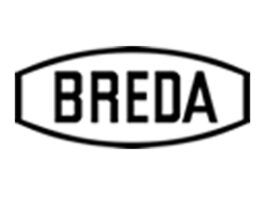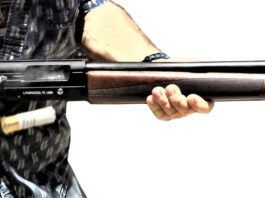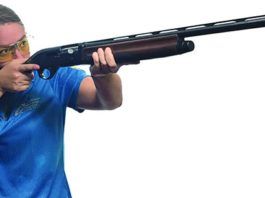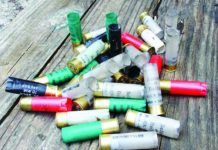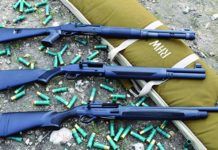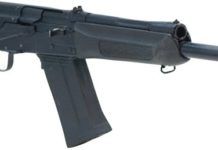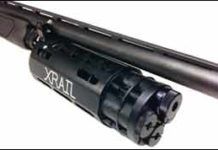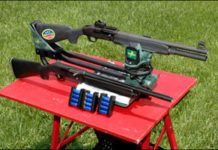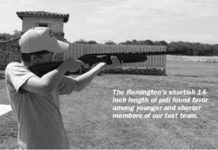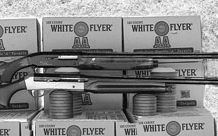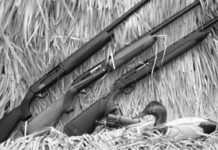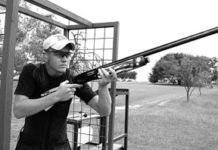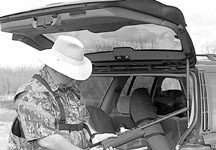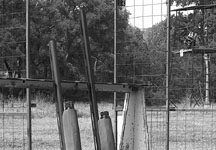Shotgun Shootout: Self-Loader, Pump, or Dual-Action Design?
When we decided to test three tactical shotguns suitable for home defense, rather than test three pumps or three self-loaders, we tested one of each, and one that could be either. The Benelli Nova Tactical Pump was our first type, followed by a semi-auto Mossberg 930 Tactical and TriStar's TEC-12, the latter of which can operate as a pump or semi-auto. If we were jumping into the sandbox at the moment, we think the Benelli M3 might be our choice, especially after firing the near clone of it, the TEC-12. However, the team thought the Benelli Nova pump had the simplest action to use well, and for us, its performance could not be faulted. The Mossberg 930 Tactical had its advantages as well, among them being it was the most comfortable shotgun to fire and use. We had our preference, as we describe below, but you may decide one of the others is better for you. To make that decision easier, our shooters went over the three guns with an eye toward finding flaws, and before we begin in earnest, we will say we found few problems, and that any of these three would do good duty for home defense.
We have had generally good luck with Benelli's Nova variations over the years. Way back in July 2007, we tested the field-grade Benelli Nova Pump 12 Gauge and gave it an "A-" for its overall performance, the feel and function of the synthetic stock and forearm, and its selection of choke tubes, which was impressive for this bargain-priced firearm. Then in the October 2013 issue, we tested a Benelli Super Nova Tactical No. 29155 12 Gauge. That gun earned an "A-" grade, losing out to a less expensive Stevens 320 that was every bit as good as the Super Nova and hundreds of dollars cheaper. Also, that Tactical Super Nova was the heaviest of those shotguns, which can be good or bad depending on the shooter and the load. But in that test, our shooters particularly liked the feel of the grooved polymer forearm and pistol grip. Downside: The out-of-the-box trigger pull of 8.75 pounds was too hefty for our tastes. Functionally, however, the Super Nova was fine. Those same likes carry over to a Benelli Nova H2O, which features a nickel-plated barrel, that we have not worked into a head-to-head against other corrosion-resistant units. Functionally, it has felt and operated like the other Novas we've tested, but the unit we've been shooting off and on (No. 20090, $669 MSRP) for a couple of years has open rifle sights (blade front and rear notch), which we don't like as well as the Ghost Ring sight on the Nova Tactical, and the price is a big step up from the plain black Benelli. At the time of this test, GanderMountain.com listed the H2O at $650, not including shipping and other charges such as FFL receiving fees. If you need the anti-corrosion features, you may be willing to pay the premium price for it, but for us, because of the price and the sights, we'd have to call the H2O a "B" in terms of value.
Waterfowling Shotguns: We Like The Winchester Super X3 Best
Waterfowl sportsmen have greatly changed from the days of market hunters where the daily goal was simply to put huge numbers of birds on the ground in an attempt to satisfy the family dinner needs. Of course, today's waterfowl hunters are strictly limited by migratory bird regulations restricting waterfowl hunting to non-toxic shot with very reduced bag limits on both ducks and geese.
In a way, semiautomatic shotguns designed for waterfowl hunters are like little babies in a beauty pageant. While the parents may think their youngster is the cutest thing on the planet, the pageant judges always apply their own standards and personal preferences in selecting the best in show. This similarity was brought to our attention when a reader asked for a ranking of the best semiautomatic 12-gauge shotguns for bringing down ducks and geese. Without specifying some parameters — such as most used, best handling, affordability, reliability, and a variety of other factors — there can be no single best waterfowl semiautomatic. However, to provide our readers with some options in selecting their best smokepole, we were able to come up with a comparison of four popular, moderately priced semiautomatic waterfowl shotguns. The models included a Browning Maxus, listing for $1520; a Mossberg Model 930 Waterfowl, listing for $797; a Beretta Model A300 Outlander, listing for $845; and a Winchester Super X3, with a suggested retail of $1200. Each was found to feature both favorable and unfavorable elements that varied in importance with each member of our test team. In the end, the patterning-board performance and pocketbook impact proved to be the main separating factors in our ranking.
Our selection of ammunition to test the functioning ability, patterning performance and felt recoil of the semiautomatics included both clay-target loads and a typical waterfowl load. For clays, we used the recently introduced Browning BPT 2.75-inch, 3 dram equivalent loads packing 1 1/8 ounce of No. 7.5 shot with an average muzzle velocity of 1200 fps; and B&P Competition One 2.75-inch, 28-gram loads featuring 1 ounce of No. 7.5 shot with an average muzzle velocity of 1160 fps. To test the shotguns with duck loads, we selected Federal Premium Tungsten 3-inch, 3 dram equivalent No. 2 shot loads with an average muzzle velocity of 1,400 feet per second. Here are our findings:
Semi-Auto 12 Gauges from Benelli, Beretta, and Mossberg
While pump-action shotguns have long been the traditional standard for tactical firearms, for self defense and in law enforcement or combat situations, there are several semiautomatics on the market providing another option to the shooting public. Touching off a round with every pull of the trigger in a semiautomatic, rather than having to shuck a shell into the chamber each time with a pump action, just fits the tastes of a lot of shooters on the range and when there is a need for speed in self-defense situations. In most cases, semiautomatics are slightly faster and easier to hold on target than their pump-action cousins. At the request of a reader interested in semiautomatic tacticals, we were able to obtain a trio of these special firearms to test and review.
The models included a Benelli Model M4, listing for $1,999; a Beretta Model 1301, listing for $1,075; and a Mossberg Model 930 SPX with a suggested retail of $836. Other than the pistol grip featured on the Benelli, the three shotguns were remarkably similar in appearance, with identical Ghost Ring rear sights. The difference in handling ability and speed proved to be the major factor separating the best from the rest.
In the days of old, being quicker on the draw often meant the difference between winning and losing a gun battle — with certain caveats. Accuracy and reliable functioning of the firearm were also important in situations where a shooter's life might depend upon a second, third, fourth, or fifth shot being fired quickly and effectively.
In today's world, self-defense scenarios in which multiple shots are required to eliminate a threat are, thankfully, rare for most law-abiding citizens. However, there can be cases where personal needs or personal desires can lead a shooter to look at the possibility of putting a semiautomatic shotgun into play.
Such is the case with aGun Testsreader who contacted us with a request for a review of three semiautomatic tactical shotguns readily available to today's shooting public. He specifically requested evaluations of aBenelli Model M4, listing for $1,999; aBeretta Model 1301, listing for $1,075; and aMossberg Model 930 SPXwith a suggested retail of $836. While the price range of the three semiautomatics is quite a stretch, the appearance, handling ability, and speed of the trio are very similar.
Just like in the world of clay target shooting, a key factor with semiautomatics is their ability to reliably function. Some shooters have been heard to refer to semiautomatics as "jam-o-matics" because of failures to cycle loads. On the clay target range, a jam at the wrong time can mean the loss of a target; but in a self-defense situation, a jam can leave a shooter holding a club in a gunfight.
Being certain a firearm will function every time is a very important factor in a shooter's decision to select the right firearm for the right use at the right time. To test the functioning ability, speed of fire, and speed of loading — in addition to checking the accuracy of our three semiautomatics — we selected a trio of loads that could feasibly be put into play as part of potential self-defense or possible close-combat situations. The ammunition included Remington ShurShot Heavy Dove 2.75-inch, 3.25-dram-equivalent loads packing 11⁄8 ounce of No. 6 shot with an average muzzle velocity of 1255 fps; Remington Managed-Recoil No. 00 Buckshot 2.75-inch loads moving eight pellets at an average muzzle velocity of 1200 fps; and Winchester PDX1 Defender 2.75-inch loads pushing a 1-ounce segmented rifled slug at an average muzzle velocity of 1600 fps.
We usedBirchwood Casey Eze-Score BC-27 Green Targetsfor all of our testing, with slug tests at targets set 30 yards downrange (about the maximum for a self-defense situation); and set at 20 yards downrange for the buckshot and No. 6 shot loads. Here are our findings.
In Search of the Best 12 Gauge
For those who are not in restricted states, magazine-fed shotguns can quickly switch from sporting uses to home defense and competition with some minor adjustments. In the November 2012 issue, we test-fired four high-capacity products with an eye mainly toward effective home defense, which is often done with shotguns that hold 5, 6, 7, and 8 rounds, usually in tubular magazines under the barrel. But there are bigger-capacity shotguns out there, so we examined the Akdal Arms MKA 1919 3-Inch 12 Gauge, a Red Jacket Saiga RTS-SBS-12 Short-Barrel 12 Gauge, the Kel-Tec KSG 3-Inch 12 Gauge, and the Saiga IZ-107 12 Gauge.
The KSG (Kel-Tec Shot Gun) was a bullpup pump shotgun whose short overall length tallowed for greater maneuverability, making it suitable for close-quarters combat. The KSG weighed a shade over 7 pounds and measured only 26.1 inches in length. The internal dual tube magazines held an impressive 14 rounds of 12 gauge 2 3⁄4-inch shells (seven per tube) or 12 3-inch rounds (six per tube). Because different types of loads can be placed on either side, the shooter can switch between tubes depending on his needs. There are many good fighting shotguns on the market, but no others are quite as handy and possess as much firepower as the Kel-Tec KSG, we found.
Another recommended shotgun from that test, and our favorite, was an older Saiga 12, graded as in Very Good used shape. It was manufactured at the Izhmash Factory in Russia and imported through EAA Corp. What we believe is an identical gun, the IZ-107 12 Gauge, is available from K-Var Corp. of Las Vegas (K-Var.com). Designed as an all-purpose shotgun, the Saiga comes with a chrome-lined barrel, which allows the use of many different types of ammunition, including steel. This shotgun was manufactured utilizing the Kalashnikov gas system, which reduced felt recoil dramatically over the KSG pumpgun. The Saiga shotgun was capable of cycling both 2 3⁄4- and 3-inch magnum shells. As with all Saiga 12s, this shotgun is not designed to use low-pressure shells. Saiga 12 gauges now come standard with a bolt hold-open feature, which allows for quicker magazine changes.
Since our last test, market availability for the Saiga 12 has tightened, making these shotguns difficult to come by and rather expensive — Gunbroker.com prices average around $1300 for an Izhmash-branded Saiga. We wanted to see how a Saiga-style shotgun, but made in China at less than half the price, would hold up to the real thing, so we acquired Catamount Fury and Fury II shotguns and put them through similar tests as the Izhmash Saiga. Here's what we found.
Super-Capacity Shotgun Mag: Is Roths XRAIL a Good Buy?
Semiautomatic Shotguns for Self-Defense: We Like Utility
When it comes to defending the home, the shotgun is and probably always will be a popular choice. The favorite design for this purpose has long been the pump-action shotgun. Simplicity, low cost, and reliability are their hallmarks. Cycling a pump shotgun relies directly upon the operator, while semiautos load themselves. Perhaps this is why the pump is more widely trusted. In this test we will find out if two semiautomatic shotguns can earn the same high level of confidence as the shuckers have earned. Furthermore, we'll pit a base-model autoloader against a fully dressed tactical model to see just what upgrades help or hinder. Our test shotguns were the $458 CZ-USA No. 06029 712 Utility 12 gauge and the $700 Mossberg Special Purpose 930 Tactical No. 85360. Both shotguns were constructed with black synthetic stocks and black aluminum receivers. The CZ shotgun was a basic model, as its name would imply. The Mossberg was outfitted with several upgrades from the tactical aftermarket.
To test our shotguns we did not take them to the skeet range. Nor did we take them hunting. Here is what we were looking for: First, we wanted to find out the size and the density of pattern we could deliver shooting nine-pellet 23/4-inch 00 buckshot. Our buckshot test patterns were produced from a maximum distance of 25 yards. We also fired for pattern from 30 feet, a typical distance between a bedroom door and the main entrance of a home. For this test we fired the Winchester Super X XB1200 load, the Federal Low Recoil H132 00-buck shotshells, and Rio Royal Low Recoil shotshells, No. RBLR 129. At first we chamber-loaded one at a time. Then we loaded the magazines to check for cycling. What we found was that our entire supply of Rio slugs and buckshot would be useless in this test. Neither shotgun would cycle the Rio ammunition. In fact, the Mossberg would not even allow it to enter the magazine. Both shotguns were built to chamber 3-inch rounds, so the added length of the Rio (about 0.12 inches) was not the problem. After failing to pass through a MEC shell-check gauge ($12, from recobstargetshop.com), we think it was the high-wall brass that was responsible. However, these rounds cycled easily in the two pump shotguns we tried, a Remington 870 Express Magnum and a Mossberg 590A1.
We also tried firing slug ammunition from a benchrest at a distance of 50 yards. Our choice of slugs was the Federal Vital-Shok TruBall Low Recoil Rifled Slug HP No. PB127 LRS. To help us steady the shotguns and also soak up recoil, we mounted the shotguns in a Caldwell Lead Sled. Test rounds were chronographed to measure velocity and compute muzzle energy.
Semiautomatic firearms require energy supplied by the ammunition to cycle. So we fired less powerful ammunition as well. For this segment of our test, we fired Super Sport Competition Target loads from Estate Cartridge, Inc., and another inexpensive round, Rio's Trap 32 target load. Both rounds were rated at about 1150 fps and were 23/4-inch 23/4-dram shells with 11/8 ounces of No. 8s. Each of these rounds featured low-brass hulls. Our function-fire test included a timed rapidfire exercise aimed at a steel target placed 12 yards downrange. To ensure safety we chose an Evil Roy Practice Target from actiontarget.com. The Evil Roy was safe to use because it directed the ricochet downward almost directly in front of its collapsible stand. We used a shot-activated timer to record five five-shot strings of fire beginning with an audible start signal. Our intent was to drive the guns as fast as possible to see if we could make them stumble. By racing against the clock we were adding artificial stress. In this way we hoped to learn more about the basic operation of each gun. That is, knocking off the safety, achieving a mount, finding the target and keeping our hits on steel. Start position was port arms with the butt of the gun lowered to about the belt line with the front sight, or bead, held high enough so that it was at the periphery of our sight picture between our eye and the target. Would the performance and reliability of either shotgun be enough to win over a pump-gun devotee? Let's find out.
12-Gauge Semi-Auto Shotguns: Dont Buy the Franchi I-12
Semi-Auto Shotguns: Browning Gold Sporting Beats Benelli
As the average age of clay-target shooters continues to inch higher, many veterans are turning to less expensive, lighter, softer-shooting semiautomatics as substitutes for their over-unders. The common objective is to find a firearm that doesn't strain the pocketbook; is easy on the arm muscles; and doesn't send the shooter into shoulder shock from recoil.
However, because the single-barrel shotguns are lighter and quicker to get on a target, all of them require a little more finesse if a shooter is intent on being competitive or filling a game bag. This means there is more need for a little extra push or pull by the shooter, rather than relying on the glide of a heavier stackbarrel.
The Browning Gold Sporting Semiautomatic 12 gauge, $1105, has earned a good reputation as a moderately priced shooting tool at clay target courses across the country, despite some travails. The initial burst of enthusiasm for the shotgun when it first entered the market was slightly deflated by problems with broken firing pins and other mechanical failures with early models. However, those failures seem to have subsided with the more recent production runs.
Following the pattern of the legendary Remington 1100 semiautomatic that once dominated the skeet shooting community (and also suffered some early mechanical problems); the Browning Gold Sporting has become one of those shotguns that nearly everyone gives the old college try.
But there are plenty of challengers out there vying for the Browning's sporting-clays spot, one of which is the other semi-auto in our test, the Benelli SuperSport. The model we tested is the latest version of another veteran line that has been favored by both bird and clay target shooters. With its space-age looks and feel, the Benelli SuperSport Semiautomatic 12 gauge, $1735, is one of those love it or hate it shotguns.
The sharp angle of the trigger guard and the Comfortech stock's synthetic design, plus the two-toned receiver, are all striking innovations that make the Benelli stand out in a gun rack. We found that most of these innovations earned high marks in both function and appearance for testers who like an updated look.
To put our test shotguns through their paces on the sporting clays course, our shooting crew fired a variety of ammunition, including Remington Premier STS Low Recoil 2.75-inch, 2.5-dram shells. We fired two versions of this loading, one which had 1.125 ounces of No. 8s, and the other with same payload, but in No. 7 1/2s. Both shells are low recoil, with an average muzzle velocity ranging from 1100 to 1145 fps. Because the Browning would only handle 2.75-inch shells, no 3-inch shells were used in our test sessions. Here's our test report:
Weatherbys SAS Field Kicks Grass in Duck-Blind Showdown
There's probably no activity tougher on a shotgun than waterfowling. Between the extreme elements (mud, muck, and often uncommonly cold temperatures), the tight confines of blinds, the general roughness of the sport (dogs that won't sit still, an oversized buddy who knocks something over everytime he turns around), sharp boat edges, action-clogging cattails and Johnson grass, and loads that pack significant punch, a waterfowler's shotgun takes a beating from trigger to choke tubes.
We thought it was time to examine just how far development in these guns has come, and toward that end, we acquired a trio of 3- and 3.5-inch chambered guns to shoot side by side. From Browning came the relatively new Gold FLD Stalker No. 011118304, a black synthetic-stocked 12-gauge offering that takes 3-inch shells and retails at $981. We chose the brand-spankin'-new Xtrema2 from Beretta, again in black synthetic. This model (No. J391D28) chambers up to 3.5-inch shells and hangs a retail tag of $1,498. For our last choice, we picked the SAS Field from Weatherby, No. SVF1228PGM. We had originally wanted this gun with the synthetic stock, but it was backordered at the time of testing, so we went with a wood-stock model. Retailing at $925 in the wood version (the synthetic is $879), the SAS proved a stellar competitor against the two big "B" brands.
Being May when the testing took place, duck and goose seasons were long closed. Thankfully for us shotgun nuts, sporting clays ranges are in full swing this time of year, so it's there we took our trio. The shooting gods must have been watching, because it rained during the entire testing day—is there anything more appropriate to testing duck guns?
We also put all three guns in the freezer, loaded with a variety of upland and steel waterfowl loads, and fired them immediately upon removal for function testing. Finally, we performed a point-of-impact test at 40 yards, both from a bench rest (we used the Steady Rest on the MTM shooting bench from Midway USA) and standing, using the National Target Company's clay shotgun patterning target. Here's what we found.
12-Ga. Semi-Auto Sporting Clays Shotguns: Browning Vs. Beretta
Winning or losing a sporting clays tourney can come down to hitting just one more target than your competitor. Does the Browning Gold Sporting or the Beretta AL 391 Urika give you that edge?
Winchester Super X2 Versus Mossbergs Model 935 Magnum
Having a gun safe full of firearms that can be picked through to be just the right tool at just the right time is an unattainable luxury for most average hunters and shotgun enthusiasts. More often than not, there is a "go-to gun'' that will get the job done in all kinds of conditions. Rugged, reliable workhorses that may not be as pretty as some, these firearms might be called tools of necessity.
While several steps above a power saw or set of socket wrenches, utility shotguns are expected to function well and be relatively comfortable to handle under adverse conditions. They are used in places that might not be appropriate for a finely engraved, high-grade-wood showpiece.
Falling into this category are two semi-automatics, both gas operated, being described as "workhorses'' by a couple of well-known firearm manufacturers — the Winchester Super X2 of the U.S. Repeating Arms Company Inc. and the recently released Model 935 by O.F. Mossberg & Sons Inc.
Both shotguns are designed to handle heavy-hitting 3-inch and 3.5-inch shotgun shells, which have a reputation of reaching out to touch waterfowl with killing effectiveness. However, the ammunition also has a reputation of setting some shooters back on their heels from the recoil of sending up to 1 3/8 ounces of shot into the sky.
12-Gauge 3-inch Semiautos: We Shoot the ADCO Diamond, MKV Conquest
Many all-around hunters like to keep a "user" shotgun in their collection to handle situations where rough and tumble conditions may not be favorable for a fine fowling piece. As a veteran shotgunner once said of his well-worn scattergun: "She might not be the prettiest gal at the ball, but she'll keep you dancing."
An inexpensive, all-purpose shotgun can be a useful tool. Whether you hang it on a gun rack in the back window of your pick-up truck (unloaded please) or store it at the hunting lodge to help the cook keep meat in the stew pot, you don't want anything too fancy.
Falling into that "user" category are two semi-automatics — an ADCO Diamond GE manufactured in Turkey and a MK Conquest Model 901 from Germany — we recently put through a shooting test both in the field and on some Five-Stand clay targets. Both shotguns carry a MFRP of under $500 and each featured 3-inch chambers that provide versatility in a variety of wingshooting conditions.
The concept behind extending the firearms' chambers beyond the normal 2.75 inches for standard length shotgun shells was developed to increase the tools of today's modern shotgunner. Waterfowl and turkeys are just two of the bird species that can send a hunter looking for 3-inch loads. The bigger birds often require more knockdown delivered by the longer shells, which allow for extra powder and shot.






























